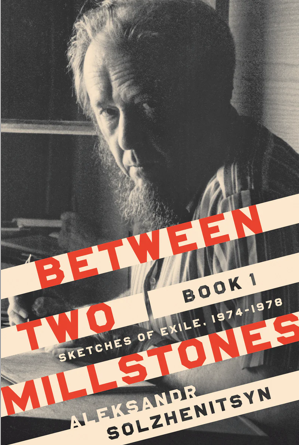Large Works & Novels > Between Two Millstones
Between Two Millstones: Sketches of exile
While the subtitle of Solzhenitsyn's memoir of his twenty years in the West, "Sketches of Exile," is a straightforward indication of its contents, the title needs some comment. In Russian, the memoir is named Ugodilo zërnyshko promezh dvukhzhernovov, an aphorism whose folksy tone might be rendered by "As luck would have it, the little grain landed smack between two millstones." The "little grain" is a metaphor for the autobiographical protagonist who is subjected to harsh criticism in the West while at the same time being vituperated in the Soviet Union. There is an element of self-irony here, since the image suggests naïve unawareness of the difficulties ahead. Some self-deprecating notes had also been sounded in the title of Solzhenitsyn's earlier autobiographical sketches, published in English as The Oak and the Calf. That title is an abbreviated version of another Russian aphorism, which, translated literally, reads "A calf butted an oak," thereby evoking an image of a rambunctious but foolishly immature creature knocking against the colossus of Soviet power in the silly hope of bringing it down.
Despite the common aphoristic provenance, however, the two titles exhibit a difference of emphasis that is remarkably consistent with the respective orientation of each text. In The Oak and the Calf the image of the sprightly young "calf" is in playful tension with the vigorous and crafty tactician depicted on its pages. In contrast, the image encapsulated in Between Two Millstones (once we consider the full original phrasing) suggests naïveté combined with a sense of unjust injury. And, indeed, Solzhenitsyn's text features more than a few bitter pages on the avalanche of uninformed, sharply hostile, and at times deliberately malicious Western criticism that he had to endure in the two decades between his expulsion from and return to Russia. It was one thing to be attacked by the Soviet state, from which he could expect nothing better, but quite another when—simultaneously—gross misrepresentations of his views were offered by influential Western commentators, and when the Western media mindlessly recycled charges of Solzhenitsyn's alleged "dangerous nationalism," "opposition to democracy," and "theocratic tendencies." Even the US Senate got into the act in 1985, holding short-lived hearings on a report that US-financed Radio Liberty was contributing to anti-Semitism by broadcasting a reading of August 1914. (The charge was quickly dropped as devoid of substance.) Criticisms of this kind, together with dismay at Michael Scammell's biography, which, in the writer's opinion, presented a seriously distorted picture of him and his works, constituted the essence of the second—Western—"millstone" grinding away at his good name. Though he reports on much of this with the sarcastic verve familiar to readers of The Oak and the Calf, it is clear that the attacks rankled.
Yet throughout this entire period, Solzhenitsyn, as Between Two Millstones testifies, exhibited a genuine appreciation for most aspects of the West. He admired the smooth functioning of local self-government in Switzerland as well as in New England, expressed deep reverence for the infinitely rich cultural legacies permeating the European countries he crisscrossed, and had high praise for the energetic efficiency he witnessed in America. It was this admirable—but, in his view, vulnerable—West that he wished to warn against the dangers of encroaching Soviet influence. But his admonitions fell on deaf ears, at least in his opinion, and Between Two Millstones documents a gradual decline of Solzhenitsyn's faith in his ability to influence his Western contemporaries. In any case, Solzhenitsyn is explicitly on record in Between Two Millstones to the effect that he could no longer subscribe to the ringing assertions about the power of literature to transmit experience across time and space which he had himself formulated in his Nobel Lecture.
Between Two Millstones is a rich conglomerate of many themes, and in some respects it resembles a diary that chronicles the major events in which Solzhenitsyn played a part after 1974. Sections of the text are pure travelogue, with vivid descriptions of journeys to various North American locales and to assorted countries in Europe and the Far East, in most cases related with panache and occasional flashes of humor. There are fascinating descriptions of one-on- one meetings with prominent individuals, including British Prime Minister Margaret Thatcher (1983) and Pope John Paul II (1993), detailed accounts of public speeches at occasions such as the Harvard University commencement (1978) and the Templeton Prize ceremony (1983), comments on TV appearances in which Solzhenitsyn took part, and explanations of the circumstances that led to the writing of particular works. Some of the important speeches and statements he produced during this period are discussed in detail elsewhere in the present volume, while in Between Two Millstones Solzhenitsyn frequently gives direct information on the themes he wished to emphasize. There are also passages on "domestic" matters, such as the efforts made to assure a proper education for the writer's three sons, and numerous accolades to his extraordinary wife, Natalia Dmitrievna, who has been able to combine the roles of wife, mother, and household manager with the functions of literary adviser, editor, and typesetter, apart from the burdens of heading the Russian Social Fund and acting as Solzhenitsyn's public representative in numerous contexts.
Much space is allotted in Between Two Millstones to Solzhenitsyn's evolving views of the processes that led to the collapse of the Soviet Union. His attitude passed from skepticism about Gorbachev's early steps, to hope that the reforms were for real, to growing apprehension that the movement would become as chaotically destructive as the February Revolution in 1917, and finally to near despair at seeing his worst fears realized. In this connection one can undoubtedly speak of a challenge to Solzhenitsyn's view of his role as writer. While he may have abandoned his hope of affecting the West, his relationship to Russia was different. In Russia, after all, he had achieved a truly massive effect through works such as One Day in the Life of Ivan Denisovich and The Gulag Archipelago. But now, amid the clamorous chaos of the Gorbachev era, the reforming potential of literature, that special power that had made it possible for "one word" to "outweigh the whole world" (to quote the ending of Solzhenitsyn's Nobel Lecture), seemed suddenly to have become impotent. A reading on the Voice of America (in the late 1980s) of March 1917, the third "Node" of The Red Wheel, specially abridged for the occasion by Solzhenitsyn in the hope of warning his compatriots of the dangers ahead, evoked only minimal response. Perhaps even more disappointing to the writer, his "Rebuilding Russia" essay (1990) was ignored or dismissed as irrelevant despite its enormous distribution. In Between Two Millstones Solzhenitsyn confesses that for him this particular disregard served to confirm the rightness of his decision to forswear Russian politics:
“What I could not attain by my pen, I would never be able to achieve by shouting orders.”
Nothing—and no effort of his—seemed capable of impeding Russia's slide into its "third Time of Troubles," and it is this realization that casts a gloomy shadow over the closing chapters of Solzhenitsyn's work.
-- from The Soul and Barbed Wire, by Edward E. Ericson, Jr. and Alexis Klimoff
------
Between Two Millstones, Book 1: Sketches of Exile (1974-1978), translated into English by Peter Constantine, appeared in October 2018 from University of Notre Dame Press as part of the Kennan Institute's Solzhenitsyn Initiative. Book 2: Exile in America (1978-1994), translated by Clare Kitson and Melanie Moore, appeared in October 2020.
Trailer
See a short video trailer about Book 1 and another one about Book 2.
ADDITIONAL Resources
Available Formats
Book 1 | Hardcover
Amazon | Barnes & Noble
Book 1 | Paperback
Amazon | Barnes & Noble
Book 1 | E-book
Kindle | Apple Books | Nook | Google
Book 2 | Hardcover
Amazon | Barnes & Noble
Book 2 | Paperback
Amazon | Barnes & Noble
Book 2 | E-book
Kindle | Apple Books | Nook | Google


